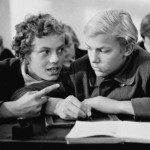 Oskar Luts (1887–1953) seems to perform the same function in Estonian literature that W.O. Mitchell does for Canada. His sequence of novels describing the lives of school children in the 1890’s, and carrying their stories forward into middle age, are loved in his homeland. These were written shortly before World War One. All three of the novels were filmed: Kevade [Spring] (1969); Suvi [Summer] (1976); Sügis [Fall] (1991). All were directed by Arvo Kruusement, with some of the same actors appearing in the lot, notably Aare Laanemets as the rascally Joosep Toots. I have all three, but I’ve only found English subtitles for Kevade.
Oskar Luts (1887–1953) seems to perform the same function in Estonian literature that W.O. Mitchell does for Canada. His sequence of novels describing the lives of school children in the 1890’s, and carrying their stories forward into middle age, are loved in his homeland. These were written shortly before World War One. All three of the novels were filmed: Kevade [Spring] (1969); Suvi [Summer] (1976); Sügis [Fall] (1991). All were directed by Arvo Kruusement, with some of the same actors appearing in the lot, notably Aare Laanemets as the rascally Joosep Toots. I have all three, but I’ve only found English subtitles for Kevade.
Kevade doesn’t have much plot. Schoolkids pull pranks, tell lies that get them into trouble, have puppy love, and get into fights with the kids in the neighbouring German parish school. At the time in question, there was no Estonia. The events take place in the Governorate of Livonia [Liivimaa kubermang], a semi-autonomous segment of the Russian Empire still administered semi-feudally by its ancient German-speaking nobility. Its territory covered half of what is now Estonia and half of what is now Latvia. There was a separate Livonian language, related to, but quite different from Estonian, spoken in part of the Gorvernorate, which is now essentially extinct (there are only 20 fluent speakers). However, the story of Kevade is set in an area near Tallinn where Estonian was spoken. The kids are required to learn some Russian in school, and buy things with rubles, but there doesn’t seem to be any significant Russian presence or cultural influence. The kids read adventure stories about American cowboys and Indians, and the state of Kentucky (!) is constantly mentioned. The landscape looks eerily like Eastern Ontario ― a gently rolling countryside in which farmland is broken up by sinuous creeks and large patches of mixed forest. The tree species are similar. The country school, farmhouses and 19th century fixtures could as easily be in rural Canada of the same era, though the sauna would only be found in Northwestern Ontario. The fancy German school, however, looks entirely European. The only thing that seems odd is the dominant hair colour. You don’t usually find a schoolroom in Canada in which three quarters of the students are platinum or flaxen blondes, with a few brunettes thrown in.
The usual Estonian tropes appear in the story: a mystical aura around trees, and the theme of redemption through music. But mostly, it’s just a set of comic episodes about misfired pranks. Valeri Blinov’s cinematography is crisp, sharply focused, and gives the film most of its strength. The young actors are believable. One gets the impression that the Estonian-language schools could not hold to the rigid Prussian discipline that, no doubt, held sway in the German schools. The teachers are portrayed sympathetically. This is no angry exposé of childhood misery and adult hypocrisy, though the story does touch slightly on injustice and death. It’s more along the lines of Ralph Connor’s Glengarry Schooldays, Edward Eggleston’s The Hoosier Schoolmaster, or W.O. Mitchell’s Who Has Seen The Wind. This is an honourable tradition in both literature and film, and Kruusement’s cinematic treatment of the story is a respectable contribution. It has nostalgia and sentiment, but it isn’t maudlin.
0 Comments.